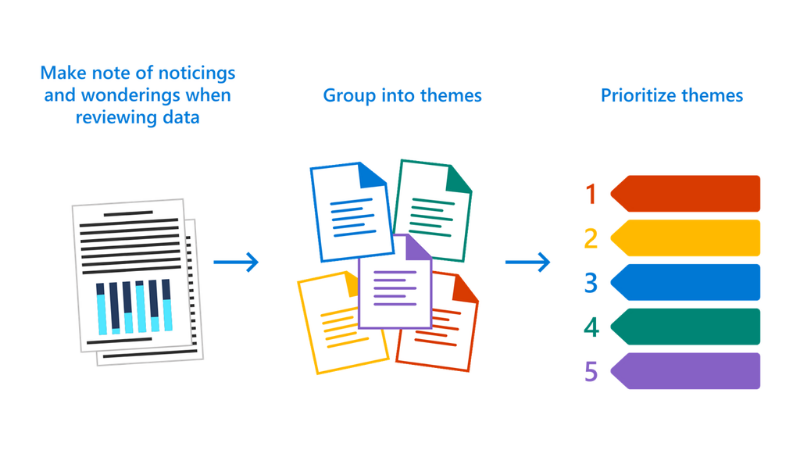Blended learning throughout a system
In the previous unit, we examined the need for a blended learning cycle of continuous improvement. You collected data as part of that process and are now ready to strategize your next steps based on your unique data set. Compile your data into a blended learning tool like Microsoft Teams. Use Microsoft Teams throughout this process as your platform for staff collaboration and reflection.
To ensure buy-in on next steps for improving blended learning, leaders should engage the instructional technology infrastructure department in the improvement process. Ongoing conversations and collaboration with your instructional technology department to address infrastructure, ongoing evolution of technology, and options for growth saves time and money.
Next, consider presenting the data to your school leadership team. Ask them to look at the data and make two lists in Microsoft Teams as they review: one list for "noticings" and one list for "wonderings."
Participants should record specific things they notice, or "noticings" in the data set including:
- Blended learning models used.
- Grade level similarities and differences.
- Student achievement differences based on the model of blended learning implemented.
- Blended learning professional development completed.
- Blended learning professional development needs.
- Infrastructure strengths and needs.
- Current challenges.
- Current strengths and resources.
Participants should then record specific things they wonder about, or "wonderings" they have about patterns they see in the data set including:
- How to address blended learning challenges.
- How to deliver and manage blended learning professional development.
- How to promote/leverage blended learning model and program strengths.
- How to increase and manage funding necessary to provide a system of blended learning that meets the changing needs of technology, infrastructure, and learner needs.
Once lists are complete, leaders should put teachers into pairs or groups of three. Have participants consolidate their lists by themes that emerge.
Next, leaders should engage the whole team in a discussion to determine and prioritize themes around blended learning improvement that emerge from the whole data set.


Backwards planning
Start with the end in mind. The American Psychological Association supports that promoting student agency is a key to motivating students. If the goal is to empower students with a high degree of control over their personal learning experience, we must put resources in place that enable students to achieve this goal.
All planning should focus on steps to refine your blended learning model to increase student agency.
Be sure to continue including your instructional technology infrastructure department in your process. They have a pulse on the infrastructure in place in your organization and what blended learning options function best within your system. In addition, funding is always a consideration.
Questions to consider in your backwards planning process include:
- Based on what we learned from our review of the data, what is our ideal vision for system-wide blended learning?
- Keeping our ideal vision in mind, how will we secure the funding required to meet changing blended learning needs over time?
- What community partners are available to support and sustain funding for devices and infrastructure?
- Do community partners have buy-in on curriculum and resources that best prepare students for the workforce in our community?
- What are other school systems doing with blended learning that we would like to emulate?
Keep your vision statement in mind as you work. Post it in common spaces so that everyone is reminded of where your educational system is headed with blended learning.
Design your blended learning model based on the current and future needs of your students. What skills do students need now? What skills will they need when they exit your school system? The blended learning model your team designs should be flexible and fluid, capable of evolving with technology to meet the growing needs of students and staff.
As you plan and work, consider the resources you currently have available. Create a progression plan that builds over time towards achievement of your ideal blended learning environment. Create small, attainable goals along the way so that you can celebrate with your staff as goal achievement occurs.